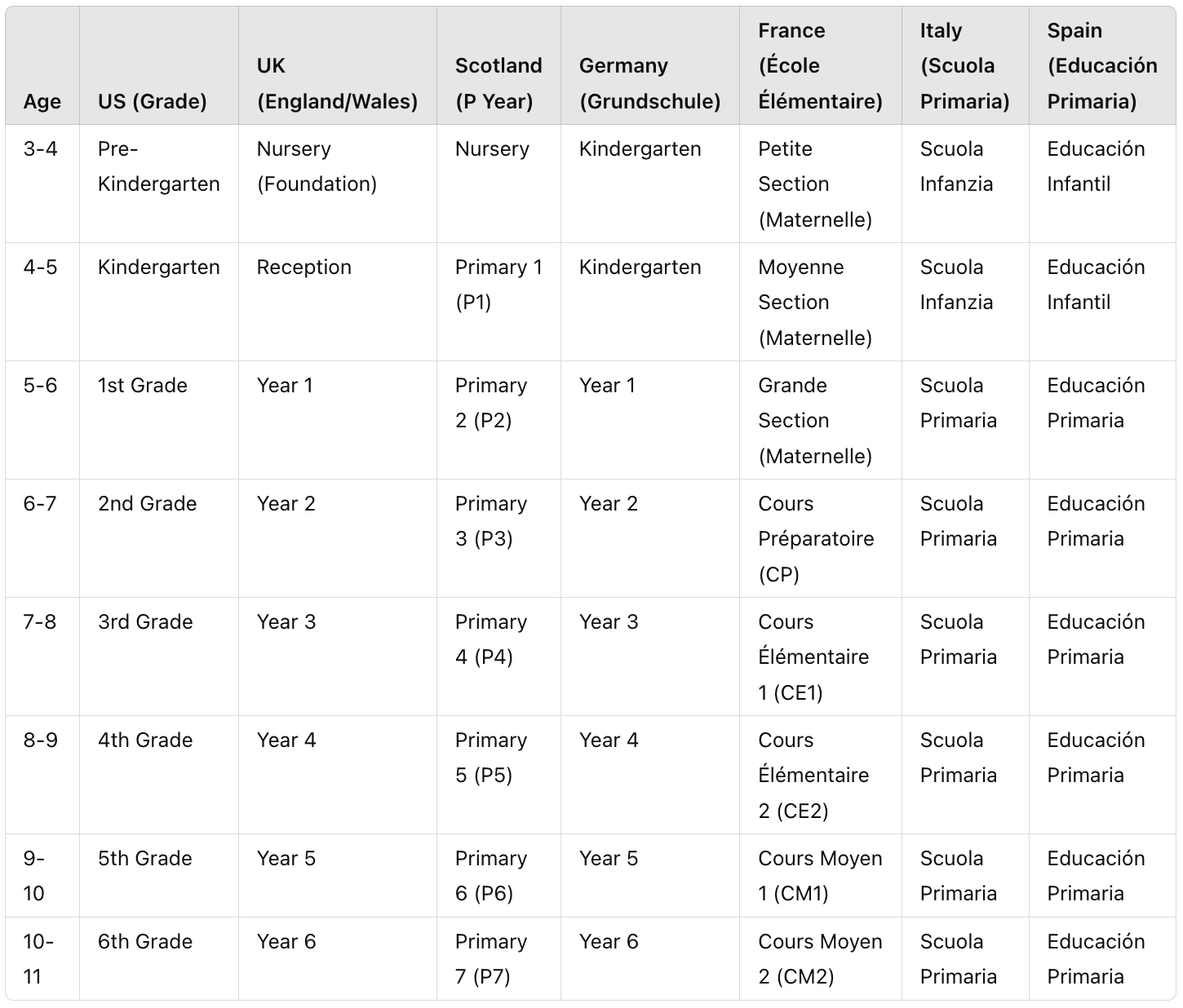
When parents move between countries or compare education systems, they often face confusion with terms like P3, Year 2, or Grade 2. Understanding how school year systems work across different countries—especially between the US, UK, and Europe—can be challenging. This guide will help you make sense of these terms, explaining how different systems align and what it all means for your child's education.
School Year Comparison: US vs UK vs Europe
The age at which children start school and progress through different grades varies across countries, but the ages typically align across many systems. Here's a quick breakdown of how the school years map across different countries:

What Does P3 Mean in Scotland?
In Scotland, P3 stands for Primary 3, the third year of primary school. Typically, children start Primary 1 (P1) around age 5, meaning students in P3 are generally 6 or 7 years old. This is equivalent to Year 2 in England and Wales or 2nd Grade in the US.
P3 is part of Scotland's Curriculum for Excellence, which emphasizes a holistic approach to early education, incorporating literacy, numeracy, and personal development skills. Northern Ireland also uses the term "Primary 3," but in England and Wales, it’s referred to as Year 2.
How Do School Year Systems Compare?
The US Education System
In the US, children typically start Kindergarten at age 5 or 6, then move through Grades 1-12 in a linear sequence. 2nd Grade, for example, corresponds to children aged 6-7, which is roughly equivalent to P3 in Scotland or Year 2 in the UK.
The UK System (England and Wales)
The UK divides education into Key Stages. After Reception, children move into Key Stage 1, starting with Year 1 at age 5 and progressing to Year 2 at age 6-7. This stage focuses on building fundamental skills in reading, writing, and mathematics, similar to P3 in Scotland or 2nd Grade in the US.
Germany’s Grundschule
In Germany, children attend Grundschule from age 6. They progress through four years of primary school, starting with Year 1. By the time they reach Year 2 (around age 7), they are in a similar position to students in P3 in Scotland or 2nd Grade in the US.
France’s École Élémentaire
French students enter École Élémentaire at around age 6, beginning with Cours Préparatoire (CP). By CE1 (Cours Élémentaire 1), students are around 7-8 years old, aligning closely with the P3/Year 2/2nd Grade level of education in other countries.
Italy and Spain: Familiar Systems, Different Names
In Italy, primary education begins at age 6, with Scuola Primaria lasting until age 11. Children in Year 2 (age 6-7) are at the same level as P3 in Scotland and 2nd Grade in the US.
Similarly, in Spain, children start Educación Primaria at age 6 and proceed through six years of primary schooling, with Year 2 (6-7 years old) matching P3 and 2nd Grade elsewhere.
Why Does It Matter?
Understanding these differences is essential for parents, especially those moving internationally or comparing school systems. If you're relocating from the US to the UK, for example, you’ll want to know that your child in 2nd Grade will be placed in Year 2 in England or P3 in Scotland. Each education system may have slightly different curricula, but the general age progression is similar.
How TinkerTell Can Support Your Child’s Learning
No matter where your child is in the school system—whether it’s P3 in Scotland, Year 2 in England, or 2nd Grade in the US—learning support is crucial. That’s where TinkerTell comes in.
TinkerTell offers personalized stories, illustrations, and learning activities, using AI to adapt to your child’s interests and reading level. Our platform is designed for kids aged 3-10, supporting both literacy development and creative growth.
Explore how TinkerTell can help your child succeed by visiting TinkerTell. With AI-powered personalization, we make learning fun and engaging, no matter which school system your child is in.
FAQs
1. What is P3 in Scotland?
P3 stands for Primary 3, the third year of primary education in Scotland. It corresponds to Year 2 in England and Wales and 2nd Grade in the US, typically for children aged 6-7.
2. What age is Year 2 in the UK?
Children in Year 2 in the UK are typically 6-7 years old. This is equivalent to P3 in Scotland and 2nd Grade in the US.
3. How do school years in the US compare to the UK?
In the US, children progress through grades starting from Kindergarten (age 5-6). In the UK, education follows Key Stages; children in Year 2 (age 6-7) are in the same educational stage as 2nd Grade in the US.
Conclusion
Understanding the differences between school year systems can be confusing, but knowing how terms like P3, Year 2, and 2nd Grade correspond to your child's age and education stage can help ease the transition when comparing systems. No matter where your child is, TinkerTell can support their learning journey with personalized, engaging content that adapts to their needs.
